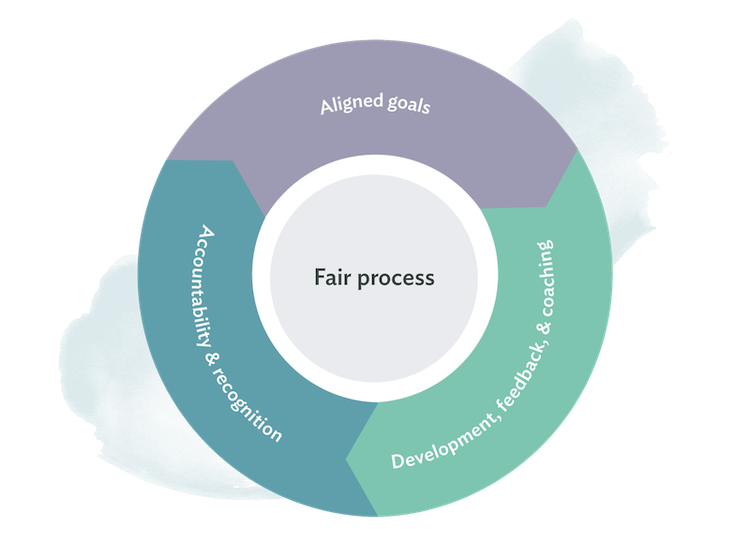
The 4 qualities of effective performance management

Written by

Former Senior People Scientist, Culture Amp
Employee performance is a major driver of organizational success. So, understandably, many companies rely on their performance management process to help their workers achieve their full potential.
But employees? They don’t have high opinions of these systems and approaches, with less than 20% of workers saying they feel inspired by their performance reviews. And leaders’ outlook isn’t much rosier. According to research from Gallup, only 2% of CHROs think their performance management system actually works.
It’s clear that organizations need to rethink their approach to employee performance and find a process that benefits everyone. But what would that look like? This guide covers the ins and outs of an effective performance management process – including why it matters, the must-have elements, and tips for aligning employee goals with your organization’s strategic objectives.
What exactly is performance management?
Performance management is the process managers use to find ways to improve employee performance. While some people conflate performance management with performance reviews, your annual review cycle is only one slice of the pie.
True performance management consists of numerous processes that not only measure performance but also support employee engagement and development, including:
- Setting personalized performance expectations and performance management goals
- Aligning individual goals to the organization’s strategic objectives
- Monitoring progress toward performance metrics and company goals
- Offering frequent feedback on employee performance
- Adjusting goals and focus areas when necessary
- Identifying career development opportunities and providing support to pursue them
Put simply, effective performance management isn’t an annual exercise – it’s an ongoing commitment.
Why does performance management matter?
Most organizations recognize the value of the performance management process. That’s because it has direct ties to many of the outcomes companies care about – including employee performance, employee engagement, retention, and overall organizational success.
According to research from McKinsey, companies that focus on employee performance reap the benefits:
- These companies are 4.2 times more likely to outperform their peers
- They realize an average 30% higher revenue growth
- They experience attrition rates that are 5 percentage points lower
Research shows that only 46% of employees report feeling satisfied with the career support they receive from their employer. If that sounds familiar, your organization’s performance management process could be the key to raising that number. Focusing on performance and development is critical for fostering an engaged, committed, and high-performing workforce.
What makes performance management so challenging?
Effective performance management matters – but that doesn’t mean it’s easy. As you set out to improve your process, you may face a few hurdles, including:
- Biases and subjectivity: Unconscious biases, favoritism, and personal opinions can skew managers’ approaches to performance management and reviews.
- Lack of transparency: Only 45% of employees strongly agree they know what’s expected of them at work, proving that many workers lack visibility into performance expectations and the performance management process as a whole.
- Inconsistent feedback: Reviews and performance-related conversations may not occur on a regular schedule. Feedback may feel too vague to be useful or focus on recent events rather than long-term performance.
- Mismatched goals: Nearly 80% of employees admit they don’t know what they’re working toward, which shows that many companies struggle to connect the dots between individual performance management goals and organizational success.
- Limited development: Some performance management systems focus on performance metrics and evaluation but forget to place equal emphasis on employee growth and career development opportunities.
- Time-consuming processes: Many managers are already overwhelmed with unreasonable workloads. They may struggle to balance the performance management process with their other responsibilities.
- Lack of manager training: Only 31% of employees agree or strongly agree that managers in their organization have received sufficient training in performance management. A lack of training can lead to inconsistencies and frustrations throughout the process.
Keep in mind that these challenges are not roadblocks. Focusing on effective performance management (and finding the right performance management software to support you) will help you overcome these common obstacles.
The 4 pillars of effective performance management
So, what goes into an effective performance management process? We consulted academic literature, industry research, and best practices in organizational psychology to find the answer. Ultimately, we identified four factors found in successful approaches to performance:
- Fairness, transparency, and accuracy
- Goal alignment and tracking
- Developmental coaching and feedback
- Accountability and recognition
Let’s take a closer look at each of these.
1. Fairness, transparency, and accuracy
It’s a common misconception that employees base their opinions about performance reviews on whether or not they get the raise or promotion (i.e., the outcomes) they want. On the contrary, researchers have consistently found that the two most important factors affecting employees’ opinions are the process itself and how employees are treated.
Research on organizational justice gives us a better understanding of what drives employees’ perceptions of fairness and value and how these perceptions influence employee attitudes and behaviors at work. Introduced by Dr. Jerald Greenberg in the 1980s, organizational justice works beautifully as a scientific model for "high stakes" processes like performance management. It consists of three factors:
Process
- Were decision-making rules clear and consistent?
- Were potential biases acknowledged and minimized?
- Did I have an opportunity to voice my input?
Interactions
- Was I treated with respect and compassion?
- Was I informed on how the process works?
Outcomes
- Did I get what I wanted?
- Was it appropriate and equitable?
While outcomes matter, this shows that bonuses, raises, and promotions aren’t necessarily the path to an effective performance system your people will appreciate and embrace.
2. Goal alignment and tracking
Understanding how your organization’s goals line up with individuals' and teams’ day-to-day work is a key component of creating a motivating approach to performance. One of the most robust findings in social and organizational psychology is that people who set goals outperform those who do not.
Organizations like Google, The Gates Foundation, and Intel all credit simple goal-setting techniques with being foundational to their exceptional achievements. Driving company goals is often cited as a reason for implementing a performance management system to begin with.
Goals aren’t the only element necessary to drive motivation, and motivation isn’t the only driver necessary for high performance. However, aligning and tracking goals will go a long way to ensuring continued success for your organization. Plus, your employees will appreciate being able to see the connection between their work and your company’s larger strategy and purpose.
3. Developmental coaching and feedback
Research has shown that high-performing organizations view "enabling employees to do their best work" as the true purpose and objective of performance management. When employees feel empowered to perform at a high level, organizations see a 23% increase in company-wide satisfaction with their performance management processes. This is why many organizations are rebranding performance management as “performance development.”
In the past, managers were often expected to act as a “boss” with a “command and control” style of leadership. In today’s modern workforce, this has been widely replaced by the manager-as-a-coach or manager-as-a-mentor model. In fact, research from Gartner found that employees who report to managers who are good coaches are 40% more engaged and demonstrate 38% more discretionary effort at work.
For that reason alone, it’s worth making developmental coaching and feedback a frequent, expected part of workplace conversations. These conversations have value, not only for managers and direct reports but also between peers and other leaders. In a study by the Institute for Corporate Productivity, researchers explored data from 234 organizations to determine which performance management practices drive business impact. They found that creating a culture of feedback was the most critical driver of positive organizational and financial outcomes.
When people see others asking for and providing feedback, learning and growth become the norm rather than the exception.
4. Accountability and recognition
Even though the trend has been for performance management approaches to place less emphasis on accountability and recognition, that doesn’t mean these elements no longer matter. In the high-stakes world of performance, accountability and recognition are just as important as ever.
In 2018, Culture Amp helped companies ask over 850,000 employees whether they agree with the following statement: “When it is clear that someone is not delivering in their role, we do something about it.”
Only 45% of employees agreed or strongly agreed with that statement. That means more than half of the employees surveyed feel uncertain – or worse – about how performance issues are handled within their organizations.
Accountability matters. When people need help, it’s up to them to ask for support, and when people do good work, they deserve recognition. Performance management systems make it easier for organizations to hold people accountable for their responsibilities and recognize when employees exceed expectations.

Performance reviews that work for you
4 performance management strategies for the workplace of tomorrow
The four pillars listed above will help you build a foundation for a solid performance management process. With that groundwork in place, here are four top performance management strategies to transform employee performance from a periodic process to a consistent priority.
1. Move toward a culture of continuous improvement
To some people, the phrase “performance management process” may make employee performance feel like a box to check. But continuous performance management isn’t something to mark as “done” and forget about. It involves prioritizing ongoing development and performance conversations rather than saving them for once or twice a year. Think: regular employee check-ins, real-time feedback, and evolving goal-setting.
This doesn’t mean foregoing your performance reviews – they’re still an essential piece of the process. But instead of viewing those reviews as the entirety of your performance management process, find ways to complement them with:
- Ongoing conversations about employee performance expectations and development goals
- Regular, real-time feedback on performance
- Frequent shoutouts, appreciation, and recognition
- Continuous goal monitoring and updates
When organizations combine traditional reviews with this more consistent approach, employees feel fully supported (instead of just evaluated).
2. Refine your performance review process
Performance reviews are valuable, but they’re not flawless. Only one-third of organizations said employees felt their efforts were evaluated fairly. And an alarming 95% of managers say they’re dissatisfied with their organization’s review system.
Again, ditching performance reviews isn’t the answer. Instead, take a close look at how you can improve your review process, including:
- Using objective criteria: Standardize performance and evaluation metrics to reduce subjectivity and biases.
- Increasing transparency: Clearly communicate how performance is measured and assessed as well as how it connects to promotions, raises, and growth opportunities.
- Incorporate 360-degree feedback: Collect insights from colleagues, direct reports, leaders, and other stakeholders to help employees get a well-rounded view of their performance.
All of these adjustments can help employees see your reviews more as an opportunity than an obligation.
3. Train your managers
If you haven’t already, train your managers about how to get the most out of the performance management process. According to research from McKinsey, investing in the coaching skills of managers is crucial for an effective performance management system.
Along with employees themselves, direct supervisors lead the charge of an employee’s growth and development. You can support them with resources and training about a variety of related topics, including:
- Giving constructive feedback: How to provide clear, actionable, and balanced feedback that’s motivating rather than discouraging.
- Conducting effective performance reviews: Structuring productive review conversations, setting expectations, and keeping discussions focused.
- Recognizing and reducing bias: Identifying unconscious biases and using structured evaluation methods to increase fairness.
- Setting clear, measurable goals: Helping employees define SMART goals that align with business objectives.
- Navigating difficult conversations: Handling sensitive discussions around poor performance, behavioral issues, or career growth challenges.
- Supporting self-assessments: Guiding employees in reflecting on their own progress and contributions.
- Using data to support evaluations: Using performance metrics, peer feedback, and objective criteria to make informed decisions.
4. Find technology that supports and simplifies performance management
Gone are the days when you’d manage employee performance on paper forms and scattered spreadsheets. Today, the right performance management software can digitize and improve your process.
Investing in a platform that streamlines goal-setting, feedback, and employee development helps transform performance management from an administrative burden to a tool for employee growth and engagement.
Wondering what to look for when evaluating performance management technology? Ideally, you want a platform that:
- Supports continuous feedback: Real-time feedback tools help employees and managers exchange insights and keep conversations going, rather than postponing them until a formal review period.
- Facilitates goal alignment and tracking: Employees should be able to set and adjust goals and see how they connect to company objectives, with clear progress tracking to keep them motivated and engaged.
- Provides actionable insights: Without action, performance data is just information. When the data you’ve collected is easy to analyze, managers can quickly identify trends, measure progress, and make informed business decisions.
- Encourages 360-degree feedback: A system that supports 360-degree feedback ensures employees get well-rounded input from peers, managers, and other stakeholders.
- Simplifies performance reviews: The right platform will make reviews more structured, transparent, and user-friendly, which reduces stress for both employees and managers.
- Integrates with your engagement and development tools: Performance management doesn’t exist in a vacuum. A platform that connects with engagement surveys, learning and development resources, and recognition tools provides a more holistic employee experience.
Culture Amp does all of this (and more) to help you build a culture of growth. Want to see how? Request a demo today.
The future of effective performance management
Overall, creating an effective performance management system that people like is the key to building a high-performing culture. It moves your organization toward an ongoing, iterative cycle of:
- Aligning goals and expectations
- Providing developmental coaching and feedback along the way
- Giving people recognition when they knock it out of the park (or redirection when they need more help)
At the center of all this is a fair, transparent, and accurate process, as depicted below.

In the past, approaches to performance primarily looked backward and reflected on the past, but today’s performance management processes focus on developing future success – and many meaningful changes make that possible.
While old-school approaches favored command and control leadership, the next generation aligns individual and organizational goals while ensuring people maintain their autonomy.
Previously, managers often determined people’s fate unilaterally. Now, leaders empower peer-to-peer feedback to help identify behaviors and performance issues that might have otherwise gone unnoticed.
Rather than a once-a-year review process, organizations are discovering the benefits of enabling continuous, semi-annual, or quarterly options.
The path to high performance isn’t a secret. It starts with a system that is clear and fair to everyone – and that’s something any organization can achieve.

